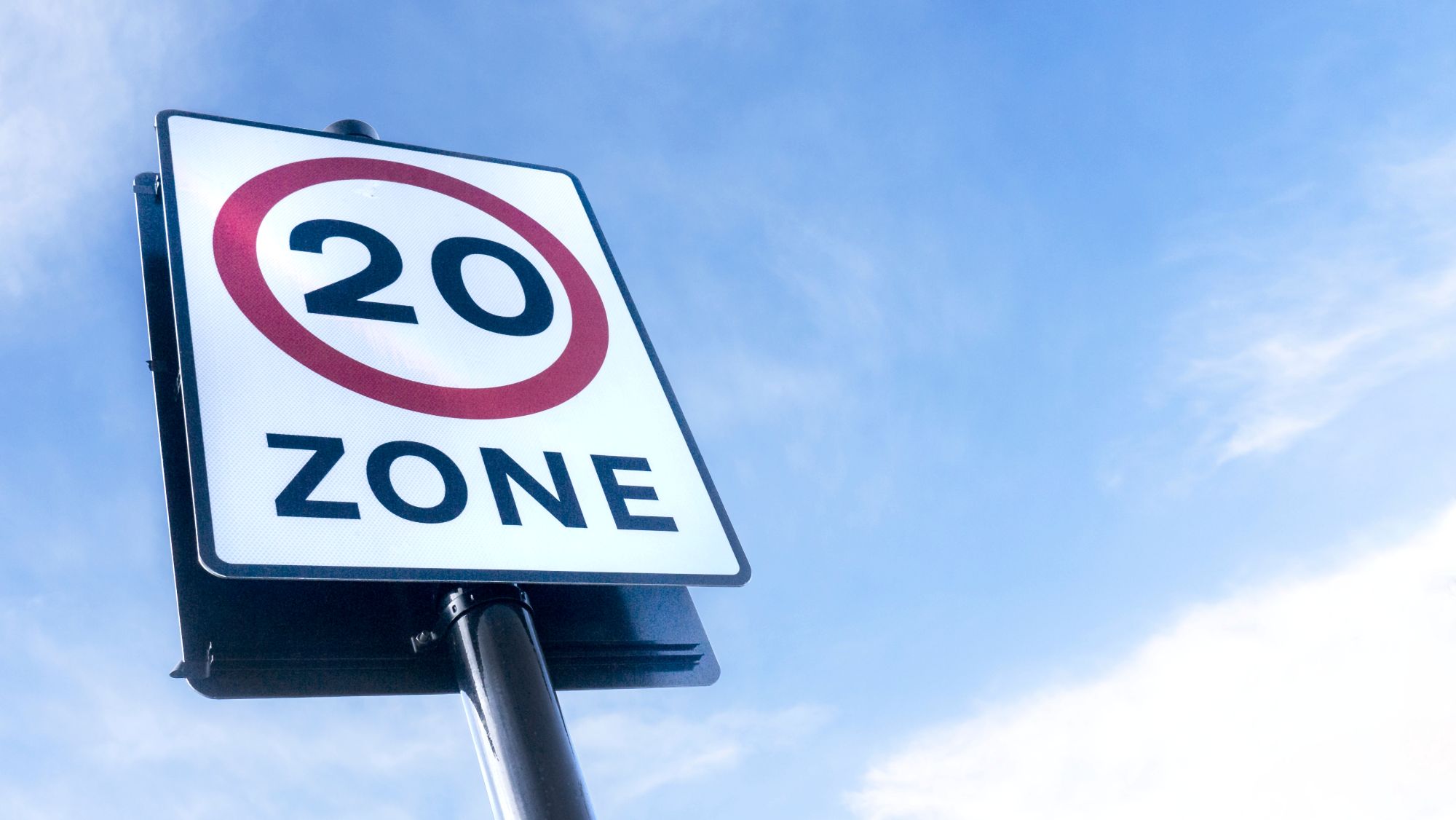
Susie Jones
Quais são as implicações dos limites de velocidade de 20 mph para as frotas?
Criado: 16/04/2025
•
Atualizado: 16/04/2025
Em 2023, 188 veículos pesados de mercadorias estiveram envolvidos em colisões que resultaram em mortes, um declínio em relação a 2022, mas ainda assim uma estatística preocupante. Estes acidentes podem ter resultado de vários fatores, como a fadiga do condutor, a má manutenção do veículo, as condições meteorológicas ou as ações de outros utentes da estrada. No entanto, os dados da organização de segurança rodoviária Brake sugerem que 58% das mortes relacionadas com a estrada tiveram a velocidade comunicada como um fator de segurança rodoviária. Neste blogue, vamos explorar a forma como a implementação de limites de velocidade de 20 mph pode ter impacto nas operações da frota e reduzir o número de mortes.
Onde ocorrem os acidentes com veículos pesados de mercadorias?
De acordo com a [EROS] (https://www.insurancerevolution.co.uk/blog/hgv-driving-safety-statistics/), apenas 10% das colisões de veículos pesados de mercadorias ocorreram numa autoestrada - os outros 90% foram mais prováveis de acontecer numa estrada urbana ou rural. As estradas rurais apresentam aos condutores de camiões espaços estreitos, curvas apertadas e interações com utentes vulneráveis da estrada, como ciclistas e peões, aumentando a probabilidade de acidentes. As zonas urbanas representam um maior risco para os condutores de camiões devido à maior densidade de tráfego, às paragens frequentes, à atividade pedonal e à complexidade da configuração das estradas - combinadas com a imprevisibilidade das estradas urbanas, tornam-nas mais perigosas para os condutores de camiões.
O impacto das zonas de 20 mph.
Os números publicados pelo [Governo do País de Gales] (https://motortransport.co.uk/industry-news/fleetcheck-urges-operators-to-back-calls-for-wider-use-of-20mph-speed-limits/25490.article) revelaram menos 100 vítimas nas estradas urbanas em 2024, em comparação com o mesmo período em 2023, antes da aplicação do limite de velocidade de 20 mph nas zonas urbanas.
O esquema é apoiado por organizações como a Brake e a Cycling UK, e agora os especialistas em gestão de frotas [FleetCheck] (https://motortransport.co.uk/industry-news/fleetcheck-urges-operators-to-back-calls-for-wider-use-of-20mph-speed-limits/25490.article) estão a encorajar as empresas de transportes a aderirem ao esquema. Argumentam que a mudança de 30mph para 20mph terá um impacto mínimo na eficiência da frota e reforçam fortemente a ideia de que salvaria vidas todos os anos.

O que é que as frotas e os condutores pensam do limite de velocidade de 20 mph?
De acordo com a FleetCheck, os operadores de transportes têm sentimentos contraditórios relativamente à iniciativa. Alguns viram as alterações como um obstáculo à eficiência, argumentando que os limites de velocidade mais baixos podem forçar algumas frotas a reduzir o número de entregas que podem efetuar num determinado período.
Nas páginas das redes sociais da SNAP, os condutores manifestaram fortes sentimentos em relação à sugestão. Um condutor comentou:
"Quem é que vai apoiar mais zonas de 20 km/h? O problema é todo o padrão de condução. Desde que saímos do confinamento, o padrão de condução tem sido diabólico, incluindo carros, carrinhas e camiões".
O sentimento permaneceu o mesmo nas redes sociais, com muitos a não apoiarem a mudança.
Os benefícios de mais zonas de 20 mph.
As zonas de velocidade reduzida oferecem vários benefícios aos condutores de camiões.
Velocidades mais baixas melhoram os tempos de reação e reduzem as distâncias de paragem, tornando mais fácil evitar colisões - especialmente em zonas urbanas.
Os camiões têm mais probabilidades de sofrer um menor desgaste do veículo com limites de velocidade reduzidos.
Os obstáculos que as empresas de frotas poderão enfrentar.
Como mencionado, algumas empresas de frotas estão preocupadas com o facto de os limites de velocidade mais baixos poderem reduzir o número de entregas que podem fazer num determinado período. As frotas também podem enfrentar os seguintes desafios:
Tempos de viagem mais longos:** afectando as entregas sensíveis ao tempo, com impacto na programação e nas expectativas dos clientes.
Planeamento de rotas:** as empresas podem ter de ajustar as rotas para ter em conta as velocidades mais baixas.
Conformidade: será crucial investir na formação adicional dos condutores para garantir a conformidade com os novos limites de velocidade.
Embora estas questões possam colocar desafios adicionais às empresas de frotas, muitas podem ser geridas de forma proactiva. Muitos argumentam que os benefícios de segurança a longo prazo ultrapassam os obstáculos.

Os números falam por si.
Numa campanha revisitada intitulada [Hazardous Highways] (https://snapacc.com/hazardous-highways/), a SNAP identificou os locais mais perigosos da GB. Aprofundámos para descobrir quais as estradas que poderiam beneficiar de um limite de velocidade reduzido.
O SNAP descobriu que o Sudeste tinha as estradas mais perigosas. Kent tem as estradas mais perigosas da Grã-Bretanha e está [a propor um objetivo de zero mortes na estrada] (https://www.kent.gov.uk/roads-and-travel/road-safety/vision-zero-road-safety-strategy?utm_source=chatgpt.com) na rede de auto-estradas de Kent até 2050. Que estradas são as mais preocupantes?
A A254:** Uma estrada curta com apenas quatro quilómetros, mas que foi considerada a estrada de maior risco da Grã-Bretanha em 2018. O relatório destacou um troço da A254 entre o cruzamento da A28 em Margate e o cruzamento com a A255 perto de Ramsgate. O limite de velocidade neste troço varia entre 30 mph e 40 mph - as áreas construídas e um fluxo de tráfego intenso do porto de Dover tornam esta estrada particularmente perigosa para ciclistas, peões e outros utentes da estrada. Este troço de estrada poderia beneficiar de limites de velocidade mais lentos?
A A252:** Conhecida pelas suas elevadas taxas de sinistralidade, a A252 tem uma extensão de 8,7 milhas. Em 2020, começaram os trabalhos para reduzir o número e a gravidade dos acidentes, entre as mudanças, uma diminuição de 60mph para 50mph neste trecho, exceto onde os limites mais baixos estão em vigor. No entanto, será isto suficiente para afastar a reputação da estrada como uma das piores da Grã-Bretanha?
Surrey e Essex também estão no topo da lista e registaram um total combinado de [30.378] (https://www.number1plates.com/blog/britains-worst-areas-for-road-accidents/#:~:text=With%2020%2C473%20recorded%20accidents%20from,as%20some%20of%20the%20worst.) acidentes nos últimos cinco anos. As elevadas taxas de acidentes em Surrey podem ser atribuídas à sua mistura de cidades populosas e estradas rurais. A sua proximidade de Londres e das principais auto-estradas resultou num maior número de colisões.
A M25: Também conhecida como Autoestrada Orbital de Londres, a M25 é uma das estradas mais movimentadas da Grã-Bretanha, sendo também a segunda estrada circular mais longa da Europa. Entre 2007 e 2016, foram registados 7 673 acidentes e 80 vítimas mortais. Sendo uma autoestrada crucial, ajustes de velocidade tão baixos como 20 mph seriam ridículos. No entanto, será que a M25 beneficiaria de zonas de velocidade reduzida?
A3:** Com uma extensão de 67 milhas, a A3 pode ser uma estrada difícil de conduzir devido ao seu elevado volume de tráfego, limites de velocidade e secções com más condições de estrada.
Perguntas mais frequentes
Qual é o limite máximo de velocidade para camiões?
Os condutores de camiões devem cumprir regulamentos de velocidade rigorosos. Estas restrições estão em vigor para ter em conta o tamanho, o peso e a capacidade de travagem de um camião.
Um camião com mais de 7,5 toneladas está limitado a uma velocidade máxima de 50 mph.
Faixas de rodagem duplas:** 60 mph é o limite máximo de velocidade para um camião com mais de 7,5 toneladas.
Auto-estradas:** Os condutores de camiões não devem exceder as 60 mph numa autoestrada.
Regulamentação dos limitadores de velocidade no Reino Unido No Reino Unido, os dispositivos limitadores de velocidade devem ser instalados em qualquer camião para limitar a velocidade máxima que o veículo pode atingir.
Requisitos legais no Reino Unido:** Todos os camiões com mais de 3,5 toneladas devem ter um limitador de velocidade fixado em 56 mph.
Como funcionam:** Os limitadores de velocidade limitam o combustível fornecido ao motor quando o veículo atinge uma velocidade predefinida, assegurando que os condutores não podem exceder o limite.
Um camião particular precisa de um limitador de velocidade?
Um camião particular não necessita de um limitador de velocidade, a menos que seja utilizado para fins comerciais. Deve declarar se o seu veículo está isento da necessidade de um limitador de velocidade quando o levar para a inspeção técnica, preenchendo um [formulário de declaração do limitador de velocidade] (https://www.gov.uk/government/publications/hgv-speed-limiter-exemption-declaration-form)



